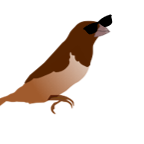a neural network toolbox for animal vocalizations and bioacoustics
Project description
vak
a neural network toolbox for animal vocalizations and bioacoustics
vak is a library for researchers studying animal vocalizations--such as
birdsong, bat calls, and even human speech--although it may be useful
to anyone working with bioacoustics data.
The library has two main goals:
- make it easier for researchers studying animal vocalizations to apply neural network algorithms to their data
- provide a common framework that will facilitate benchmarking neural network algorithms on tasks related to animal vocalizations
Currently the main use is automated annotation of vocalizations and other animal sounds.
By annotation, we mean something like the example of annotated birdsong shown below:
You give vak training data in the form of audio or spectrogram files with annotations,
and then vak helps you train neural network models
and use the trained models to predict annotations for new files.
We developed vak to benchmark a neural network model we call tweetynet.
See pre-print here: https://www.biorxiv.org/content/10.1101/2020.08.28.272088v2.full.pdf
We would love to help you use vak to benchmark your own model.
If you have questions, please feel free to raise an issue.
Installation
Short version:
$ pip install vak
For the long version, please see: https://vak.readthedocs.io/en/latest/get_started/installation.html
We currently test vak on Ubuntu and MacOS. We have run on Windows and
know of other users successfully running vak on that operating system,
but installation on Windows will probably require some troubleshooting.
A good place to start is by searching the issues.
Usage
Tutorial
Currently the easiest way to work with vak is through the command line.
You run it with config.toml files, using one of a handful of commands.
For more details, please see the "autoannotate" tutorial here:
https://vak.readthedocs.io/en/latest/tutorial/autoannotate.html
How can I use my data with vak?
Please see the How-To Guides in the documentation here: https://vak.readthedocs.io/en/latest/howto/howto.html
Support / Contributing
Currently we are handling support through the issue tracker on GitHub:
https://github.com/NickleDave/vak/issues
Please raise an issue there if you run into trouble.
That would be a great place to start if you are interested in contributing, as well.
Citation
If you use vak for a publication, please cite its DOI:
License
is here.
Misc
For more on the history of vak please see: https://vak.readthedocs.io/en/latest/reference/about.html
"Why this name, vak?"
It has only three letters, so it is quick to type, and it wasn't taken on pypi yet. Also I guess it has something to do with speech. "vak" rhymes with "squawk" and "talk".
Does your library have any poems?
Contributors ✨
Thanks goes to these wonderful people (emoji key):
 avanikop 🐛 |
 Luke Poeppel 📖 |
 yardencsGitHub 💻 🤔 📢 📓 💬 |
 David Nicholson 🐛 💻 🔣 📖 💡 🤔 🚇 🚧 🧑🏫 📆 👀 💬 📢 ⚠️ ✅ |
 marichard123 📖 |
This project follows the all-contributors specification. Contributions of any kind welcome!
Project details
Release history Release notifications | RSS feed
Download files
Download the file for your platform. If you're not sure which to choose, learn more about installing packages.




















